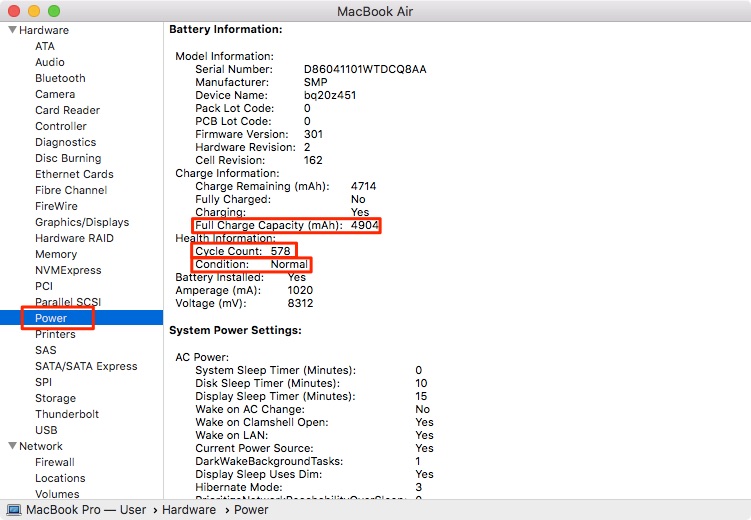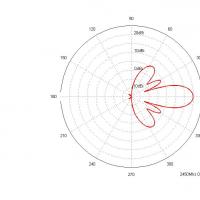How to check MacBook battery charge cycles and capacity. What are MacBook recharge cycles and how long will they last? Macbook pro recharge cycles
Apple is famous for its high-quality, but rather expensive products. Their devices are not like gadgets from other companies. Therefore, their approach to use is completely different. Most frequently asked question which bothers users and Pros is how to charge a MacBook. This issue is important to study, since its durability and maintenance of functionality will depend on proper handling of the charger.
Battery life is one of the important criteria when choosing and using any equipment. In addition, it is important to consider his ability to work in offline mode and its reload speed. Despite the quality and reliability of Apple products, careless and improper handling of equipment leads to its breakdown and shortening its service life.
Main rules
Charger for MacBook It will be much easier and safer if you follow the basic rules on how to do it correctly:
- When you turn on your MacBook for the first time, it is recommended that you do not turn off charging until charging is complete. full customization. The battery should reach 100%.
- If a person works on a MacBook every day, it is necessary to use it on battery power for at least a few hours. Only after this you can charge it from the mains.
- If your MacBook runs on mains power for days, you should completely discharge it once a month. This in a simple way you can extend the life of the battery.
By following these simple rules, you can improve battery performance and preserve it for a long time.
For many it is a misconception, that the number of charge cycles is a certain indicator of the “mileage” or condition of the battery, in fact, even with a larger number of cycles, the battery can be in full working order.
Ways to extend battery life

MacBook recharge cycles designed for 1,000 times. After 500-700 cycles, the battery wears out and begins to hold a charge for much less time than before. How can you increase its service life:
- Sudden temperature changes generally negatively affect the performance of both the battery and other components of the MacBook.
- When you plan to leave the MacBook and not use it for a long time, it is better to leave the charge at 50%, since a fully charged battery negatively affects the condition of the battery.
- It is recommended to turn on your MacBook every day. His battery doesn’t like to “stand idle.”
- To increase battery life, the screen brightness can be kept down to 75%. Low brightness prolongs battery life.
How to charge a MacBook without a network
What to do if there is no outlet nearby, and turning on the MacBook is vital. It is best to have an external BatteryBox on hand. Its capacity is 50 W/hour. It comes complete with a charging cord. Thanks to this portable device MacBook Air can work up to 12 hours, and MacBook Pro – up to 6 hours. The BatteryBox is fully charged in 9 hours and is designed for 3000 cycles, which is on average 3 times longer than the life of a MacBook battery. The weight of the portable charger is 300 grams.
There are no charging cycles on iMacs, including the most powerful and expensive ones.
Do you use a MacBook? Do you often work without being connected to an outlet, “on battery”? Then this information will definitely be useful to you. Friends, I myself am used to autonomy, so I often work wirelessly until the laptop dies. But alas, every year the MacBook holds its charge less and less, you have to get used to solving your problems faster (just kidding). Of course, ideally you need to change the battery, I wrote about this in a separate post. But on the other hand, many people don’t know how to generally check the condition of the Mac’s battery, or what its service life is. So today I will tell you how to do it yourself.
So, to check the battery status, you do not need to resort to separate programs - macOS system allows you to easily cope with this task. To do this, click on the apple in the corner of the screen, select “About this Mac”.
Then click the “System Report” button.

In the system window that opens, select “Power” from the list on the left. We are specifically interested in these indicators: “Number of recharge cycles” (Cycle Count), “Condition”, and “Full Charge Capacity (mAh). Have you checked? Let’s move on.

I saw articles on the Internet that described how to check the number of recharge cycles, but there was not a word about the full capacity of the battery (and its remaining capacity). But in fact, this is a very important indicator, because the number of cycles may be small, but the MacBook sits down very quickly, and in the meantime you will be wondering what the reason is.
There are several options here. First, if you left the laptop “idle” for a long time, that is, it was lying long time completely discharged, but idle time is fraught with the slow “dying of the battery.” The second case, if, on the contrary, you were constantly working from the network, then the battery ceases to function normally, since its “services” are not in demand. Well, thirdly, probably the most obvious - you can “kill” the battery, or the one whose output power does not match your version of Mac. You can find out the factory (initial) battery capacity of your particular model on the official Apple website. After that, compare this indicator with yours and a lot will become clear.

And now about recharge cycles. If you use your MacBook in normal mode, that is, both on mains power and on battery power, then the number of recharge cycles is usually a fairly accurate indicator. All MacBook batteries (except some before 2010) are rated for 1000 cycles. This is the battery life declared by the manufacturer, after which it may become completely unusable.
But note that time battery life will begin to fall much earlier; this can be replaced from about the three hundredth cycle. Therefore, you can “torment” the battery for up to 1000 cycles or more, but there will be little pleasure from this. Here you will have to choose, if you need a laptop that works for as long as possible without recharging, you will have to change the battery. And I wrote about how to preserve your Mac battery for as long as possible
Modern MacBooks combine a high level of software optimization and balanced Hardware, which allows Apple laptops to work quickly and, just as importantly, for a long time. Of course, no matter how capacious and high-quality the battery is, it still remains a “consumable”: after years, when the number of battery charging cycles goes beyond several hundred, the user invariably faces a noticeable reduction in the autonomy of the device.
Today we will tell you how many charging cycles it can withstand “in good health”, and also look at some of the technical subtleties of how Apple laptop batteries work.
To begin with, it is worth noting that the MacBook battery charging cycle is considered completed only when the device has completely used up 100% of the charge. In other words, if you fully charged your MacBook from 30% to 100%, the full cycle will be counted only after the battery is discharged to 70%, that is, the remaining charge from the previous use will be used up.
You can check the number of battery charge cycles in the “System Report” menu. To access this menu, click the Apple icon in the top control bar and select About This Mac. In the pop-up window, click “System Report” and go to the “Power Options” section. We are interested in the item “Number of recharge cycles”.

Note that when buying a used MacBook, you should pay special attention to this indicator. You may need to replace the battery when purchasing a laptop second hand.
In recent years, Apple has significantly increased the life of its batteries. Thus, the number of battery charging cycles for MacBooks and MacBook Airs released before 2009 is 300 recharges, which allows you to use the laptop without replacing the battery for one year. The exception is the MacBook Air mid-2009 and MacBook 2008 in an aluminum case; their service life is 500 cycles, which can provide one and a half to two years of operation. MacBook Pros also had a lifespan of 300 cycles until the end of 2008.
During 2009, the MacBook and MacBook Pro received a new battery with a resource of 1000 recharge cycles. The MacBook Air acquired a similar battery only a year later, at the end of 2010. From then until today, any MacBook has a declared resource of 1000 recharge cycles, which allows you to work with the laptop for three years.
Remember that when your MacBook battery reaches its maximum number of charge cycles, the battery life is considered exhausted. However, with sufficiently careful operation, the MacBook can last longer - the system itself monitors the condition of the battery and is able to notify the user when the battery begins to fail.
In this article, I will tell you how to check the health of the battery and, if necessary, calibrate the MacBook battery.
MacBook batteries do not last forever and lose about 30% of their capacity in one and a half to two years. When this happens, you will notice that the laptop has begun to work noticeably less, and you will see a warning about charging problems. This is exactly what happened to me when the battery capacity dropped by only 25%.
In this article, I will tell you how to check the health of the battery and, if necessary, calibrate the MacBook battery. I will show you using my 2015 12-inch MacBook as an example.
 macOS tells you your MacBook battery needs service
macOS tells you your MacBook battery needs service 1. Check the battery condition
Apple measures battery health in recharge cycles. That is, how many times your laptop has been fully charged and discharged.
For example, one day the laptop could be used until half of its charge was exhausted, and then it was completely recharged. If the same thing happened the next day, then this is considered one recharge cycle, not two. Thus, one recharge cycle can take several days.
For most MacBooks released after 2009, Apple specifies a battery life of 1,000 cycles. After using up 1000 cycles, the battery loses its maximum capacity and battery life decreases.
From my experience, I will say that when there is a 20% loss of capacity, you notice something is wrong. At 30% you already start sounding the alarm and googling solutions.
To check your battery performance, install the free coconutBattery utility.
 Battery status of my MacBook 12"
Battery status of my MacBook 12" As you can see, already at 668 cycles, the battery of my 12-inch MacBook has lost 30% of its capacity, and macOS scares me with “Service Required” messages.
But, there is always a possibility that the low maximum battery capacity is an error in the power controller. In a MacBook, the functions of the power controller are performed by SMC- System Management Controller.
2. Reset SMC parameters
The power controller records the maximum capacity of the battery, upon reaching which it stops charging, and the power indicator lights up 100%.
It happens that these values get lost, and the SMC controller stops charging earlier than necessary. Or it turns off the MacBook when 20% of the charge remains. All this shows that the battery capacity limits are written incorrectly in the SMC.
 List of problems that can be resolved by resetting the SMC. Apple website
List of problems that can be resolved by resetting the SMC. Apple website The SMC reset algorithm depends on the MacBook model, but it boils down to holding down a few buttons while booting.
If the MacBook was complaining about the battery health due to an SMC error, then the warning will disappear and the current capacity will increase slightly.
But in order for the controller to record new battery capacity values, the laptop must be completely discharged and charged.
3. Calibrate your MacBook battery
To completely drain your battery, the Blender Benchmark test suite works well. This benchmark shows how quickly your system can render a video scene. During the test, the laptop processor is loaded at 100%, which helps drain the battery faster.
Before you start Blender, turn off automatic sleep. To do this, move the slider “Turn off the monitor after...” to the far right position.
▸ System Settings… ▸ Energy Saving ▸ Battery
 Disable your laptop's automatic sleep mode to prevent it from falling asleep during the Blender test
Disable your laptop's automatic sleep mode to prevent it from falling asleep during the Blender test Now launch Blender Benchmark and click the Run Complete Benchmark button. On a top-end iMac, the test takes an hour and a half. Most likely, the laptop battery will run out sooner. My MacBook died halfway through the first rendering scene, and there are six in total.
 Blender will drain the battery of any MacBook in a couple of hours
Blender will drain the battery of any MacBook in a couple of hours After turning off the laptop, do not put it on charge immediately, but leave it in this state for another hour. And only then fully charge and check your health again with the utility coconutBattery.
Calibration helped me only slightly. Health “rose” by 3%: from 70.5% to 73.4%. And the battery capacity of 150 milliamps: from 3713 to 3862. This means that the battery has lost capacity irrevocably. It's time to change it.
 After calibration, the battery health improved by 3%
After calibration, the battery health improved by 3% 4. If all else fails, change the battery
If all these tricks do not work, then the battery is dying and should be replaced in the coming months.
At the official Apple service center, battery replacement for my MacBook Air 11″ and MacBook 12″ costs $129 apiece.
You can save money if you buy Chinese analogues. As a rule, batteries already come with a set of screwdrivers, and instructions for replacing them can be found on ifixit.com.
5. Install the Endurance utility
If you need to extend your battery life right now, try Endurance.
 Endurance can limit CPU frequency when battery is low
Endurance can limit CPU frequency when battery is low This program:
- slows down the processor frequency, which reduces its power consumption;
- “puts to sleep” inactive ones, but open applications, which consume a lot of energy;
- takes over the screen brightness adjustment and changes it more aggressively than the operating system itself.
Endurance can extend battery life by 15-20%. But at the cost of reducing laptop performance. Therefore, Endurance is more of a temporary solution. If the battery is already worn out, then it is more logical to replace it.
🌿 Remember
- The MacBook battery is designed to last 1,000 charge cycles. But in reality, after 2 years it loses 20-30% of its capacity. The laptop will work less and may shut down without warning;
- The battery capacity and the number of recharge cycles can be checked using the coconutBattery utility;
- Try resetting the SMC power controller and calibrating the battery;
- If calibration does not help, the battery life has already expired. It needs to be replaced.
Many owners of Apple laptops eventually complain after several years of using it. This is not surprising: over time, the battery life is depleted, so after two years your MacBook Pro will no longer last 8 hours as after purchase. How can you determine when the battery (or the laptop itself) is time to change?
To find out the number of recharge cycles (this is how the “health” of the battery is determined), you need to go to the Apple menu - “About This Mac” - “System Report” - “Power Options”. Here you will find all the information you need, including battery information.


How to calculate one recharge cycle? For example, if your MacBook is fully charged and you use up 50% of the charge, then charge again to 100% and use up 50% again, that would be one cycle. Such a system allows Mac computers serve for many years - many do not accumulate more than 300 cycles during the entire period of use. Let's talk about what cycle value can be considered optimal.
The maximum number of recharge cycles for your computer can be found in the table below. If for a new one this value is, for example, 1000, then the 2009 MacBook can only boast 300.
Checking periodically



